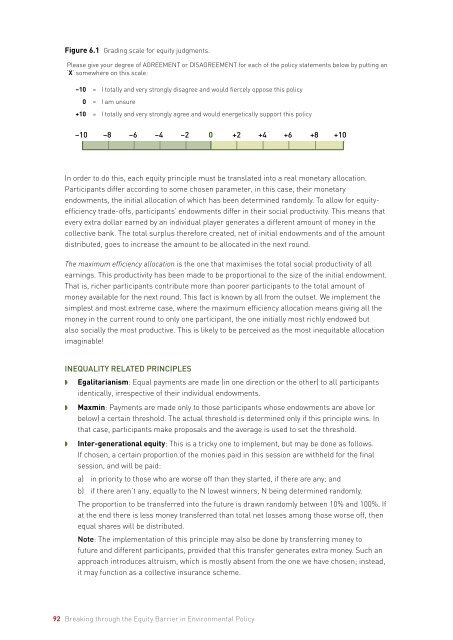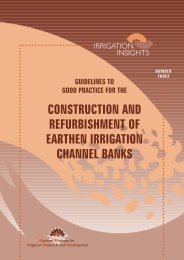Final Report Breaking through the Equity Barrier in Environmental ...
Final Report Breaking through the Equity Barrier in Environmental ...
Final Report Breaking through the Equity Barrier in Environmental ...
- No tags were found...
You also want an ePaper? Increase the reach of your titles
YUMPU automatically turns print PDFs into web optimized ePapers that Google loves.
Figure 6.1 Grad<strong>in</strong>g scale for equity judgments.<br />
Please give your degree of AGREEMENT or DISAGREEMENT for each of <strong>the</strong> policy statements below by putt<strong>in</strong>g an<br />
‘X’ somewhere on this scale:<br />
–10 = I totally and very strongly disagree and would fiercely oppose this policy<br />
0 = I am unsure<br />
+10 = I totally and very strongly agree and would energetically support this policy<br />
In order to do this, each equity pr<strong>in</strong>ciple must be translated <strong>in</strong>to a real monetary allocation.<br />
Participants differ accord<strong>in</strong>g to some chosen parameter, <strong>in</strong> this case, <strong>the</strong>ir monetary<br />
endowments, <strong>the</strong> <strong>in</strong>itial allocation of which has been determ<strong>in</strong>ed randomly. To allow for equityefficiency<br />
trade-offs, participants’ endowments differ <strong>in</strong> <strong>the</strong>ir social productivity. This means that<br />
every extra dollar earned by an <strong>in</strong>dividual player generates a different amount of money <strong>in</strong> <strong>the</strong><br />
collective bank. The total surplus <strong>the</strong>refore created, net of <strong>in</strong>itial endowments and of <strong>the</strong> amount<br />
distributed, goes to <strong>in</strong>crease <strong>the</strong> amount to be allocated <strong>in</strong> <strong>the</strong> next round.<br />
The maximum efficiency allocation is <strong>the</strong> one that maximises <strong>the</strong> total social productivity of all<br />
earn<strong>in</strong>gs. This productivity has been made to be proportional to <strong>the</strong> size of <strong>the</strong> <strong>in</strong>itial endowment.<br />
That is, richer participants contribute more than poorer participants to <strong>the</strong> total amount of<br />
money available for <strong>the</strong> next round. This fact is known by all from <strong>the</strong> outset. We implement <strong>the</strong><br />
simplest and most extreme case, where <strong>the</strong> maximum efficiency allocation means giv<strong>in</strong>g all <strong>the</strong><br />
money <strong>in</strong> <strong>the</strong> current round to only one participant, <strong>the</strong> one <strong>in</strong>itially most richly endowed but<br />
also socially <strong>the</strong> most productive. This is likely to be perceived as <strong>the</strong> most <strong>in</strong>equitable allocation<br />
imag<strong>in</strong>able!<br />
Inequality related pr<strong>in</strong>ciples<br />
w Egalitarianism: Equal payments are made (<strong>in</strong> one direction or <strong>the</strong> o<strong>the</strong>r) to all participants<br />
identically, irrespective of <strong>the</strong>ir <strong>in</strong>dividual endowments.<br />
w<br />
w<br />
Maxm<strong>in</strong>: Payments are made only to those participants whose endowments are above (or<br />
below) a certa<strong>in</strong> threshold. The actual threshold is determ<strong>in</strong>ed only if this pr<strong>in</strong>ciple w<strong>in</strong>s. In<br />
that case, participants make proposals and <strong>the</strong> average is used to set <strong>the</strong> threshold.<br />
Inter-generational equity: This is a tricky one to implement, but may be done as follows.<br />
If chosen, a certa<strong>in</strong> proportion of <strong>the</strong> monies paid <strong>in</strong> this session are withheld for <strong>the</strong> f<strong>in</strong>al<br />
session, and will be paid:<br />
a) <strong>in</strong> priority to those who are worse off than <strong>the</strong>y started, if <strong>the</strong>re are any; and<br />
b) if <strong>the</strong>re aren’t any, equally to <strong>the</strong> N lowest w<strong>in</strong>ners, N be<strong>in</strong>g determ<strong>in</strong>ed randomly.<br />
The proportion to be transferred <strong>in</strong>to <strong>the</strong> future is drawn randomly between 10% and 100%. If<br />
at <strong>the</strong> end <strong>the</strong>re is less money transferred than total net losses among those worse off, <strong>the</strong>n<br />
equal shares will be distributed.<br />
Note: The implementation of this pr<strong>in</strong>ciple may also be done by transferr<strong>in</strong>g money to<br />
future and different participants, provided that this transfer generates extra money. Such an<br />
approach <strong>in</strong>troduces altruism, which is mostly absent from <strong>the</strong> one we have chosen; <strong>in</strong>stead,<br />
it may function as a collective <strong>in</strong>surance scheme.<br />
92 <strong>Break<strong>in</strong>g</strong> <strong>through</strong> <strong>the</strong> <strong>Equity</strong> <strong>Barrier</strong> <strong>in</strong> <strong>Environmental</strong> Policy
















